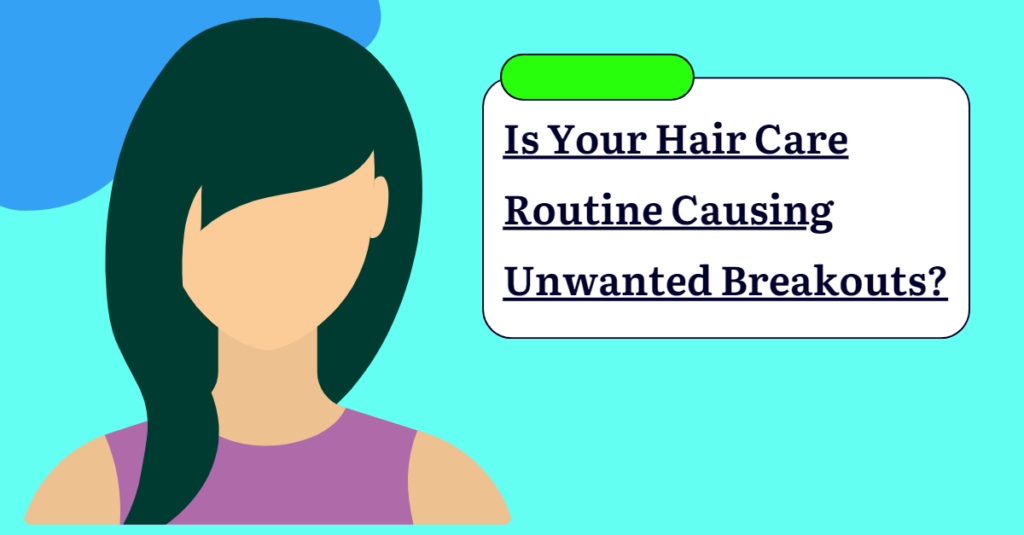Is Your Hair Care Routine Causing Unwanted Breakouts?
We all desire lustrous, healthy hair and clear, blemish-free skin. However, it’s disheartening when we invest time and effort into our hair care routine, only to be plagued by stubborn breakouts. While we often associate acne and blemishes with factors like diet, hormones, or stress, it’s important to recognize the potential role of our hair care products in this equation. Could the very products we rely on to enhance our hair be secretly sabotaging our complexion?
In this comprehensive article, we delve into the intriguing connection between hair care routines and unwanted breakouts. We explore the potential culprits lurking within our beloved hair products and shed light on how they might contribute to acne-prone skin.
-
The Hair-Skin Connection
To unravel the mystery behind hair care products and breakouts, we must first understand the intricate relationship between our hair and skin. Our scalp produces natural oils (sebum) to moisturize and protect the hair and scalp. However, excessive sebum production can lead to oily scalp and, in some cases, contribute to breakouts on the forehead, hairline, and even the back.
-
Pore-Clogging Culprits
One of the main factors contributing to breakouts caused by hair care products is the presence of pore-clogging ingredients. Certain oils, such as coconut oil and some silicone derivatives, have a high comedogenic rating, meaning they are more likely to clog pores and lead to acne. Additionally, heavy and occlusive styling products, like waxes and pomades, can trap dirt, sweat, and sebum on the scalp, creating an ideal environment for acne-causing bacteria to thrive.
-
Harsh Chemicals and Irritants
Another aspect to consider is the presence of harsh chemicals and irritants in hair care products. Ingredients like sulfates, parabens, and artificial fragrances can strip the scalp of its natural oils, disrupt its pH balance, and cause inflammation. Irritated skin is more prone to breakouts, and the use of such products can exacerbate existing acne conditions.
-
Transfer of Product Residue
It’s essential to acknowledge the potential transfer of hair care product residue from the hair to the face and shoulders. Throughout the day, hair brushes against our skin, depositing oils, styling products, and dirt onto our complexion. This transfer can clog pores and trigger breakouts, especially for individuals with sensitive or acne-prone skin.
-
Hair Styling Practices
While hair care products play a significant role, our hair styling practices can also impact the occurrence of breakouts. Tight hairstyles like ponytails, braids, or buns can exert constant friction and pressure on the scalp, leading to a condition known as traction alopecia. This condition weakens hair follicles and increases the risk of inflammation and subsequent breakouts.
-
Prevention and Solutions
The good news is that with a few adjustments to your hair care routine, you can minimize the risk of unwanted breakouts. Here are some tips to consider:
a. Read Labels and Choose Wisely: Look for hair care products labeled as “non-comedogenic” or “oil-free.” Opt for gentle, sulfate-free shampoos and conditioners without artificial fragrances.
b. Avoid Heavy Styling Products: Opt for lighter, water-based styling products that won’t weigh down your hair or clog your pores. Choose alcohol-free alternatives whenever possible.
c. Cleanse Properly: Thoroughly rinse your hair and scalp to remove any residue. Consider using a clarifying shampoo once a week to eliminate buildup.
d. Practice Gentle Hair Handling: Avoid tight hairstyles that pull on the scalp. Opt for looser, more relaxed styles and use soft hair ties or scrunchies to minimize friction.
e. Keep Hands and Hair Off Your Face: Be mindful of touching your hair and face throughout the day. Regularly clean your hairbrushes and avoid resting your hair on your face or shoulders.
f. Consistent Skincare: Maintain a regular skincare routine tailored to your skin type. Cleanse, exfoliate, moisturize, and protect your skin to reduce the risk of breakouts.
g. Seek Professional Advice: If you’re struggling with persistent breakouts despite adjusting your hair care routine, consult with a dermatologist. They can provide personalized recommendations and treatments.
Conclusion (Is Your Hair Care Routine Causing Unwanted Breakouts?)
In conclusion, understanding the potential impact of your hair care routine on breakouts is crucial. Pore-clogging ingredients, harsh chemicals, transfer of product residue, and hair styling practices can all contribute to unwanted blemishes. By choosing non-comedogenic products, practicing gentle hair handling, keeping hands and hair off your face, and maintaining a consistent skincare routine, you can minimize the risk of breakouts. If problems persist, consulting with a dermatologist can provide personalized solutions. With careful consideration and adjustments, you can achieve a harmonious balance between healthy hair and clear, radiant skin.

My name is Rohit Vagh and I’m a content writer specializing in fashion and lifestyle. I have three years of experience in this field and have written various articles. My writing style is creative and engaging, and I strive to create content that resonates with my readers. I have a deep passion for fashion and am constantly researching the latest trends and styles to make sure my readers are up to date. I’m excited to continue my career in blogging, and I’m always looking for new opportunities in the fashion and lifestyle space.





